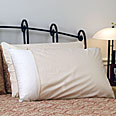Useful Bedding Tips
Allergy Free Bedding Tips – Dust Mite Covers
 Our issue on pillows produced a lot of a mail- here is a useful tip from a member on making your own dust mite pillow covers and encasings.
Our issue on pillows produced a lot of a mail- here is a useful tip from a member on making your own dust mite pillow covers and encasings.
From: Carol A. Childress
Subject: bedding
Dear Mercia and Friends,
I’m so glad to see you are going to help educate us on bedding products. It’s so easy to get confused there. I too tried one of those memory foam pillows for one night and the gas gave me a terrible asthma attack. What a crock! For those of us allergic to down, wool, and those poor souls who can’t even touch latex, it always seems to come back to cotton doesn’t it? God’s miracle plant really.
I have a couple of tips to offer if anyone is interested.
If you have some weird shaped items like neck roll pillows, bedrests (backrest pillow with “arms”), and such, you can make your own allergen barrier covers by cutting up one of the mattress covers. Just use aluminum foil to mold around the item to make pattern pieces, add a seam allowance, and put a zipper in the longest straight seam. Use as short a stitch length on your machine as possible without “perforating” the fabric to the point it will tear. It doesn’t have to be a work of art. You are just looking for something to go under the fabric cover that will block a few more dust mites. If you are totally terrified of sewing machines, duct tape will do the job. Nobody will know.
If you don’t have removable covers on your pillows, well make some of those too! I have done this will all the pillows in my house, even the cat and dog beds (especially those). Choose a very tight weave fabric like chintz, which is harder for hair, fibers, and other hard-to-clean stuff to get poked through. You can also get king size 180 – 220 thread count sheets and cut them up. This is one way to match things to your bedding. I have several sets of pillow covers I can change. So easy to wash it all together when I change the sheets on the bed.
This all came about when someone told me to wrap my pets’ foam bed inserts in plastic garbage bags, in order to keep the hairs from poking through the covers. It really worked great. I just used wide tape to wrap the bags around the foam, and put the covers back over it. It was so much easier to vacuum the hair off after that. This led to making my own better quality (and fully washable) covers, and then to cutting up the allergen covers for other uses.
There’s one other crazy thing I’d like to mention for those choosing a mattress. This won’t work for many, but it is never discussed as an option by doctors and those giving advice. I bought an old-style waterbed many years ago for back problems, and it turned out to be great for my allergies. It is the kind that is a plastic bag type of mattress in a wooden box frame, no foam or fabric at all. Nothing for the dust mites to live in. There is a blanket-thin mattress pad that goes on under the sheets, which can be washed and bleached in the washer as often as I change the sheets. The mattress itself and the crevices around the sides are all easily vacuumed while the sheets are off. No need to ever flip the mattress of course, and the adjustable heating eliminates the need for a lot of bulky and dusty covers.
This is just a thought for those unlucky few that are still having trouble even with the mattress covers. They never talk about air mattresses either, same idea there. It’s worth looking into if you have run out of options.



